10 Sending and Viewing Mail
Send and view mail from a portal using WebCenter Portal’s Mail service or your local mail client.
Permissions: To perform the tasks in this chapter, you must be granted at least the portal-level permission
View Pages and Contentto view mail. You can view mail only for assets for which they haveviewpermission.Authenticated users require the portal-level permission
Customize Pages, and must haveviewpermission on the resource.
Note: Some of the tasks discussed in this chapter are not available if mail is not configured. Portal managers can add the Mail viewer to a portal, as described in Adding Mail to a Portal in Building Portals with Oracle WebCenter Portal.
Topics:
Parent topic: Connecting and Collaborating with Other Users
About the Send Mail Feature
Throughout WebCenter Portal, you can click the Send Mail icon (Figure 10-1) to mail directly from another feature, such as events. You need to have the required permissions to work with the other features in order to use the Send Mail feature from the feature.
Figure 10-1 Send Mail Icon

Click the Send Mail icon to open a mail compose window prepopulated with information including the event details like title, organizer, date, time, and links to the Event and the portal. You can edit and add to the mail as necessary.
Note: To use WebCenter Portal’s Send Mail (not your local mail client), you must change the mail preference (see Selecting Your Preferred Mail Connection). If you are using your local mail client, you are required to log in to mail if you are not logged in (see Logging in to Mail). Log out and then log back in to WebCenter Portal after you change your preferences.
The way the mail window is prepopulated depends on the asset sending it. For example, from a wiki, Send Mail opens a mail window prepopulated with the name of the wiki, the size, who created it and when, who modified it and when, and a URL link to the wiki.
Mail, is by default, addressed to all members of the portal. Portal managers can configure the distribution list.
Tip: With the Microsoft Outlook local mail client, you must configure Outlook to support comma-delimited mail addresses.
Configuring the Send Mail Feature
The Send Mail feature does not require the mail service to be configured. That is, even if mail has not been configured in WebCenter Portal, the Send Mail feature is available using WebCenter Portal’s Mail service.
Your system administrator determines the mail client that the Send Mail feature uses: either WebCenter Portal’s Mail Service or a Local Mail Client. The default value is Local Mail Client. If your system administrator enabled users to override this mail client setting, then you can select a different mail client on the Preferences - Mail page (Figure 10-2).
Figure 10-2 Preferences - Mail Page
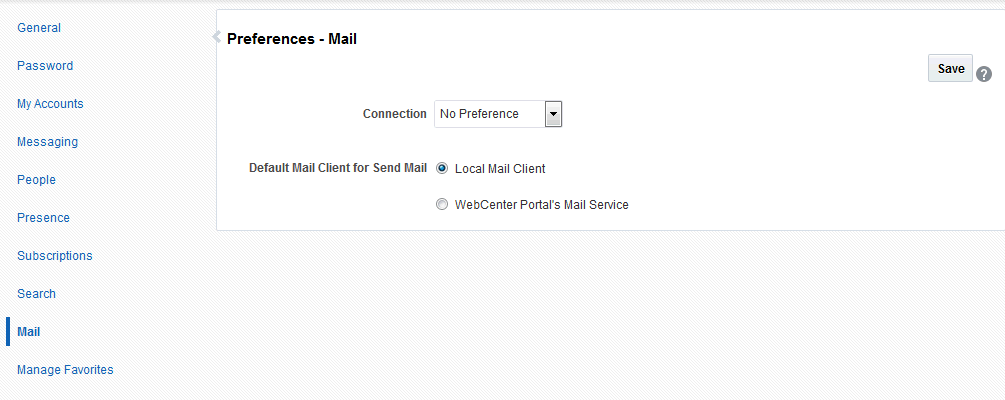
See Selecting Your Preferred Mail Connection for more information about setting mail preferences.
About Mail in WebCenter Portal
WebCenter Portal conveniently exposes familiar mail functionality. Mail is managed on the same mail server that provides your regular business mail, and the mail messages exposed are the same messages you would see in your mail inbox. Many of the same actions are also supported. For example, you can send messages with attachments, forward messages, and so on. The mail feature does not replace your company mail, but rather enhances it by making it accessible within WebCenter Portal.
WebCenter Portal’s Mail service enables users to perform simple mail functions, such as view, read, create and create with attachments, reply, forward, and delete. All mail is stored in your inbox and can be accessed from there through a link.
WebCenter Portal fetches mail from the inbox folder only. It does not support fetching mail from other folders or moving messages. It supports any mail server based on IMAP4 and SMTP protocol. WebCenter Portal provides access to multiple mail connections. You can use a different mail connection by selecting it in WebCenter Portal’s Preferences settings. For more information, see Selecting Your Preferred Mail Connection.
The Mail viewer exposes features from your mail server (Figure 10-3).
Figure 10-3 Mail in WebCenter Portal

The Mail viewer presents the following:
-
A menu for specifying which messages to display
-
A Compose icon for starting the process of creating a new message
-
A Refresh icon for updating new messages
Note that the mail viewer does not render embedded images. If an email contains inline images, they are shown as attachments, and not within the message body.
A default distribution list containing all the portal members is created upon portal creation. The portal manager can also select a different distribution list. As members are added to or deleted from the portal, the mailing list is updated automatically.
You can mail other users or any user recognized by the back-end mail server by adding their mail addresses in the To field.
Selecting Your Preferred Mail Connection
When WebCenter Portal provides access to multiple mail connections, it also provides a way for you to choose which connection to use.
Note: You can choose your preferred mail connection only if your system administrator enabled users to override this mail client setting.
To choose your preferred mail connection:
-
From your user menu in the menu bar, select Preferences.
-
On the Mail page, from the Connection drop-down list, select the mail connection you want to use for accessing your mail through WebCenter Portal.
The options available in this list depend on the connections your system administrator makes available to WebCenter Portal. The No Preference option uses your system-level active mail connection.
Figure 10-4 Preferences - Mail Page

-
Under Default mail client for Send Mail action, select an option to identify the mail application to open when the
SendMailcommand is invoked.Choose one of the following options:
-
Local mail client—Select to specify that the local mail client you normally use, such as Microsoft Outlook, should open a compose message window when the
SendMailcommand is invoked. -
WebCenter Portal’s Mail Service—Select to specify to open WebCenter Portal’s Mail service compose message window when the
SendMailcommand is invoked.
-
-
Click OK to save your changes and exit Preferences.
-
Log out of WebCenter Portal.
-
Log in to WebCenter Portal.
If you previously saved your credentials for this mail connection to the WebCenter Portal credential store, then you are logged in to the new mail connection automatically.
If you have not previously saved your credentials, log in to this mail connection using Preferences (see Providing Login Information for External Applications) or using the login link where you see mail (see Logging in to Mail).
Working with Mail
WebCenter Portal’s mail feature exposes your company’s mail features within the context of your portal. You can view, respond to, and manage your personal mail.
This section provides information about how to use mail in WebCenter Portal. It includes the following topics:
Logging in to Mail
If you are using your local mail client, before you can access your mail in a portal, you must provide your mail login credentials. The first time you access mail, it displays the message depicted in Figure 10-5.
Figure 10-5 Mail Login Message

To log in to mail:
-
Click the Login to Mail link (Figure 10-5) to open an External Application Login dialog (Figure 10-6).
Figure 10-6 External Application Login Dialog
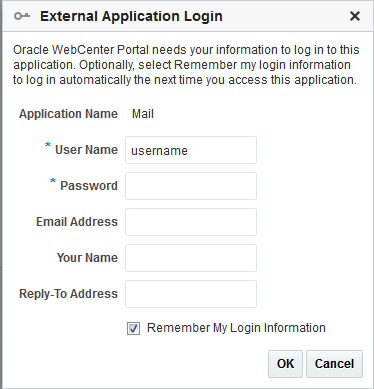
Note: The External Application Login dialog may include additional fields and information, depending on the requirements of the mail service that provides it. For more information about external applications and storing your login credentials in WebCenter Portal, see Providing Login Information for External Applications.
-
Enter your user name and password and any other login credentials that your mail application requires.
Required fields are marked with an asterisk (*).
-
Optionally, deselect or keep selected the Remember My Login Information to store your credentials.
The next time you log in to WebCenter Portal, your mail credentials are retrieved from storage and you are logged in.
-
Click OK, and mail displays from your inbox.
Personalizing Your View of Mail
You can personalize your view of the mail by filtering the number of displayed messages. For example, you can choose to display only the messages that were delivered Today, Since Yesterday, This Week, or This Month. Additionally, you can choose to display All messages in your inbox.
Note: By default, the 50 most recent mail messages from your mail server inbox folder are displayed.
Personalizations affect only your view of mail. No other user’s view is changed because of your selection.
To personalize your view of mail:
-
In the Mail viewer, click the drop-down list (Figure 10-7).
Figure 10-7 Mail Personalization Menu
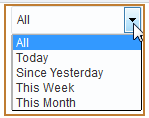
-
Select a display option from the available options:
-
All—to show all messages
-
Today—to show all messages received today
-
Since Yesterday—to show all messages received yesterday and today
-
This Week—to show all messages received in this calendar week
-
This Month—to show all messages received in this calendar month
The mail view refreshes, displaying only those messages that match your selection.
-
Opening Mail Messages
The messages that display in your mail are the same messages that display in your regular mail application inbox. You open them in the same way too. Note that the mail viewer does not render embedded images. If an email contains inline images, they are shown as attachments, and not within the message body.
To open a mail message:
-
Click the link to the message you want to open.
-
After reading the message, click Cancel to close the message.
Note: HTML reports, tables, inline images (copy paste), and fonts viewed in a mail message may not render correctly. The Mail service requires HTML data to be well-formed to display as expected in a mail message.
The mail should show everything that your browser supports. However, some tags, like <script>, are encoded and disabled from execution.
Downloading Mail Attachments
Note that the mail viewer does not render embedded images. If an email contains inline images, they are shown as attachments, and not within the message body. Attachments display in mail messages as links (Figure 10-8).
Figure 10-8 Mail Attachment
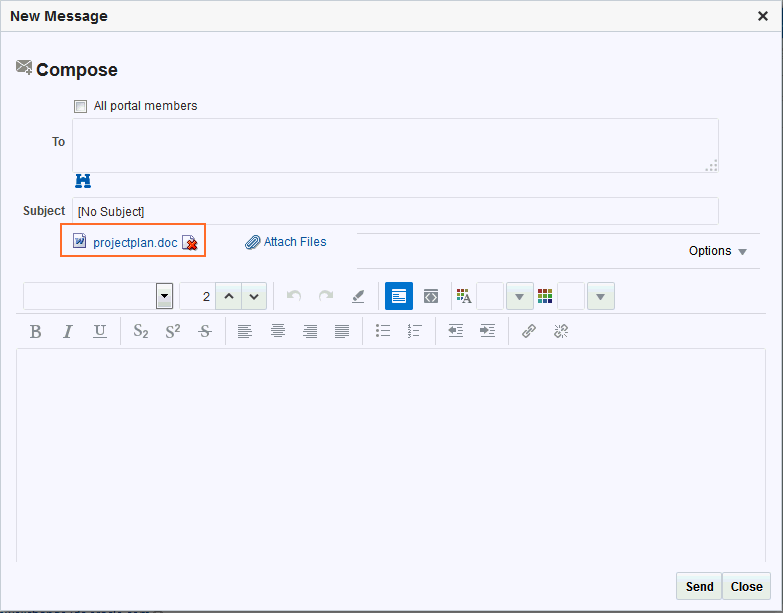
Accessing files associated with attachments is the same as accessing a file from any browser window.
To view an attachment, click the link. Clicking an attachment link opens a download dialog that gives you the option of viewing the file in its native application or saving the file to a locally. This is browser behavior, so the behavior depends on the browser you use.
Composing and Sending Mail Messages
Whether you are composing and sending messages through WebCenter Portal’s Mail or using your local mail client, it is the same as doing so in your regular mail application.
To compose and send a mail message:
-
Click the Compose icon (Figure 10-9).
Figure 10-9 Compose Icon in Mail

-
In the Compose window (Figure 10-10), do one or both of the following:.
-
Select All portal members to send mail to the entire distribution list containing all the users who are members of the portal
-
Enter recipients in the To field. Separate multiple addresses with a comma (,)
Figure 10-10 Compose Window
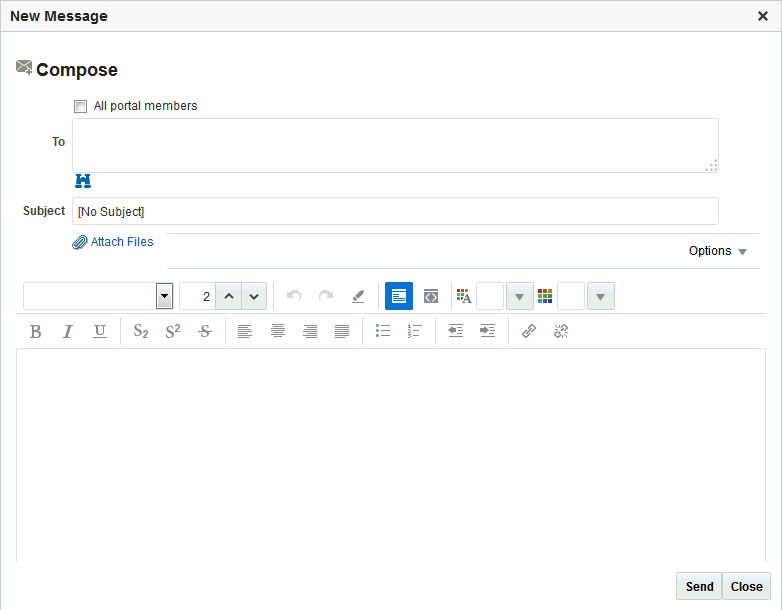
-
-
Optionally, click the Options drop-down list (Figure 10-11):
-
Select Show CC field, Show BCC field, Show Reply-to field to include these fields in the message.
The Reply-to field is prepopulated with the user composing the mail (Figure 10-11), but it can be changed to any address.
-
Deselect Use rich text editor to compose the message in plain text, instead of the rich text editor. The Use rich text editor option is selected by default.
The selected options persist until they are changed.
Figure 10-11 Options in the Mail Compose Window
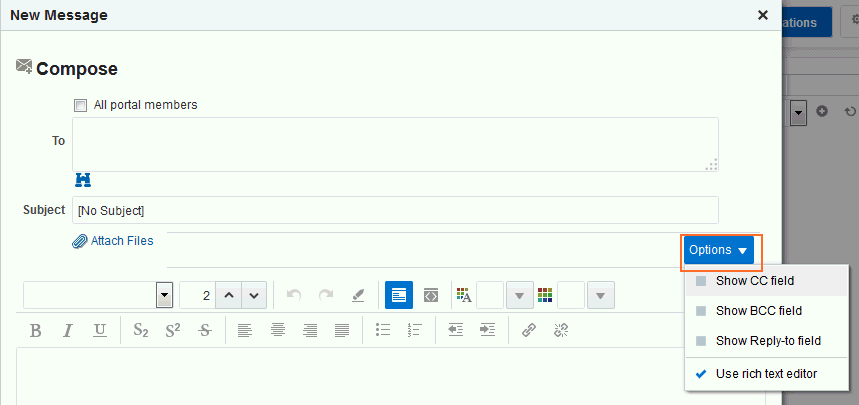
-
-
Optionally, click the Find User icon to find mail addresses (Figure 10-12).
The Compose window is directly connected to your mail server, so you can use the Find User icon to find mail addresses and contacts.
Figure 10-12 Find User Icon in a Compose Window

The Select User window opens. Enter a search term and click the Search icon.
Tip: For tips on searching with the Find User icon, see Searching for a User or Group in the Identity Store in Building Portals with Oracle WebCenter Portal.
-
In the Subject field, enter a subject for your message.
Enter up to 255 characters.
-
Compose your message in the message body.
-
Click Send.
Sending Mail with Attachments
Just like your regular mail, you can send messages with attachments.
To send a mail with attachments:
-
Create a mail message as described in Composing and Sending Mail Messages.
-
In the Compose window, click the Attach Files link (Figure 10-13).
Figure 10-13 Attach Files Link
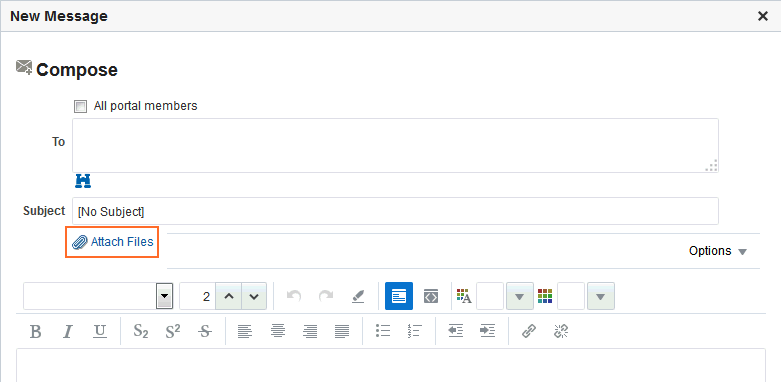
The Add Attachment window opens.
-
Click Browse to locate and choose an attachment.
-
Click Attach to attach the selected file.
The file size must be greater than zero bytes but less than 2 MB. Zero-byte files do not get attached.
Note: It is recommended that you avoid attaching large files, as this causes the server to slow down or not respond. If you attach large files (greater than 2MB), then because of how the HTTP protocol handles attachments, the system reports an error only after reading all of the 2MB characters.
-
Repeat steps 3 and 4 to add additional attachments.
Attachments are listed under the Attachments heading in the Add Attachment window (Figure 10-14).
Figure 10-14 Attachments in the Add Attachment Window
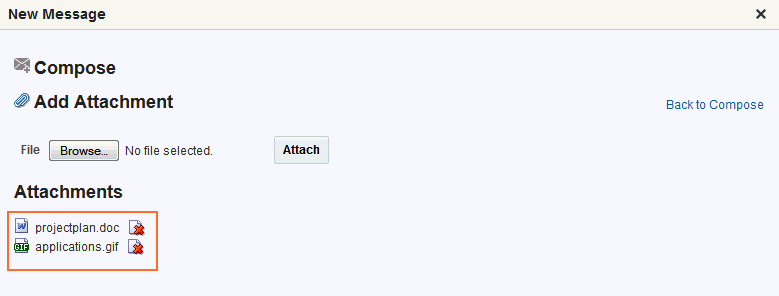
A Remove Attachment icon appears next to each attachment (Figure 10-14). Click this to remove a selected attachment from the window.
-
Click the Back to Compose link to go back to the Compose window.
-
Click Send.
Removing Attachments from the Add Attachment Window
You can remove attachments from the Add Attachment window and from the Compose window:
-
To remove mail attachments from the Add Attachment window, click the Remove Attachment icon next to the attachment you want to remove (Figure 10-15).
Figure 10-15 Remove Attachment Icon in the Add Attachment Window
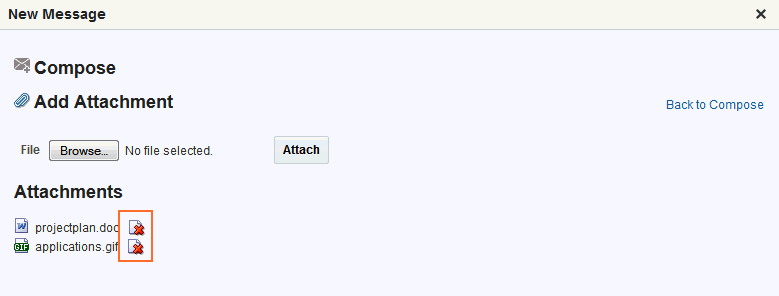
For information about accessing the Add Attachment window, see Sending Mail with Attachments.
-
To remove mail attachments from the Compose window, click the Remove Attachment icon next to the attachment you want to remove (Figure 10-16).
Figure 10-16 Remove Attachment Icon in the Compose Window
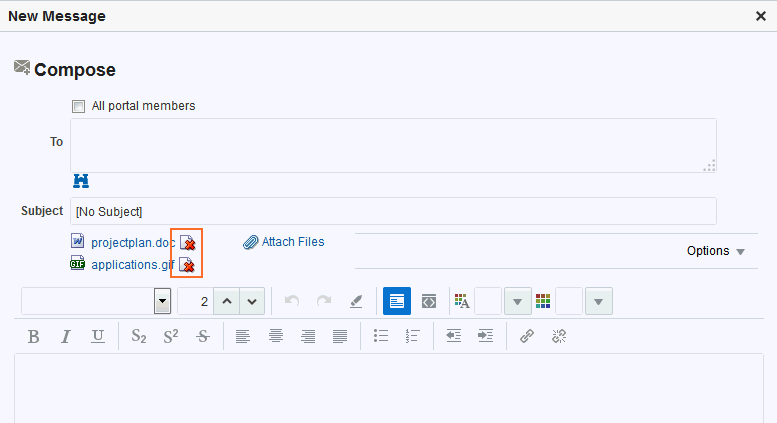
For information about accessing the Compose window, see Composing and Sending Mail Messages.
Replying To and Forwarding Mail
When you reply to or forward a mail message, the mail content is sent as an attached HTML file instead of being displayed in the mail message window. Replying to and forwarding mail is as straightforward as in your regular mail application.
To reply to or forward a mail message:
-
Click the link to the message you want to reply to or forward.
-
Select one from the following options:
-
Click Reply to reply to the sender.
-
Click Reply All to reply to all recipients (including users who received a blind copy).
-
Click Forward to send the message on to a third party.
Notice that the original mail is an HTML attachment.
-
-
In the resulting Compose window, select All Portal Members to send mail to the entire distribution list or enter recipients in the To field as you require.
Separate multiple entries with a comma (,).
Click the Options drop-down list to add Cc, Bcc, or Reply-to fields or to remove the rich text editor and use plain text.
The Compose window is directly connected to your mail server, so you can use the Find User icon to find mail addresses and contacts. Click the Find User icon and, in the resulting dialog, enter a search term for a user. For tips on searching for a user in the identity store, see Searching for a User or Group in the Identity Store in Building Portals with Oracle WebCenter Portal.
-
Optionally, revise the subject in the Subject field.
-
In the mail’s message area, enter your reply or any forwarding message before or after the original message.
-
Optionally, add attachments as described in Sending Mail with Attachments.
-
Click Send.
The message is sent, and the original message reappears.
-
Click Cancel at the bottom of the original message to close the window.
Refreshing Mail
You must refresh to check for new mail messages. Because the refresh operation triggers an event to the server to check for new mail, it may take a while to get new messages. Therefore, you may have to refresh a couple of times or so to display new mail.
- To refresh mail, click the Refresh icon (Figure 10-17).
Note: Do not click the Reload or Refresh button in your browser. Click the Refresh icon to update your view.
Figure 10-17 Refresh Mail Icon

Deleting Mail
You can easily remove a message from your inbox.
To delete a mail message:
-
Open the message you want to delete (see Opening Mail Messages)
-
Click Delete at the top of the message (Figure 10-18).
Figure 10-18 Delete Icon in a Message Window

-
Click the Refresh icon in the Mail view to remove the message from the list (see Refreshing Mail).